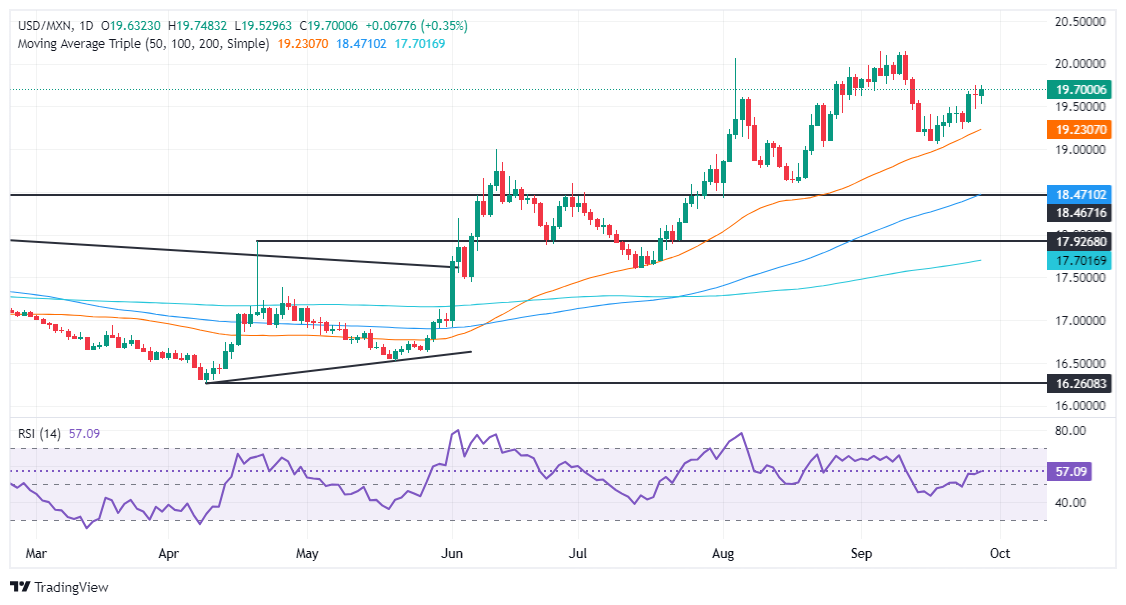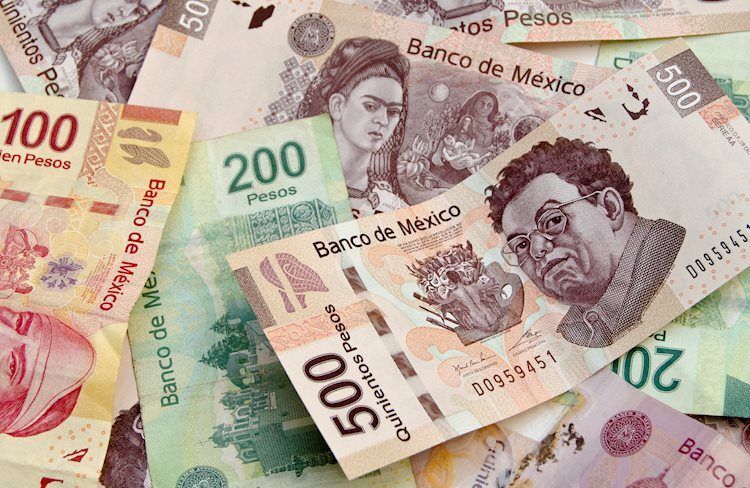- Mexican Peso extended its losses for the second straight day as USD/MXN hit a 19.74 peak.
- Banxico cuts rates to 10.50%, weakening the Peso as economic activity cools and inflation projections rise for 2024.
- US PCE inflation edged lower, but core PCE remains within the Fed’s comfort range of 2%-3%.
The Mexican peso lost steam on Friday against the US Dollar after inflation data in the United States (US) edged lower and failed to underpin the Mexican currency. However, the recent Bank of Mexico — known as Banxico — decision to lower interest rates weakened the Peso. At the time of writing, the USD/MXN trades at 19.72, gaining 0.50%.
The Federal Reserve’s favorite inflation gauge, the Personal Consumption Expenditures (PCE) Price Index, was lower than expected in August, according to the US Bureau of Economic Analysis (BEA). The same report showed that core PCE, which excludes volatile items like food and energy, ticked up by a tenth, yet it remains within the 2% to 3% range.
Further data showed that Personal Spending and Personal Income showed signs of deceleration, while the University of Michigan Consumer Sentiment for September, in its final reading, improved.
In Mexico, Banxico decided to cut interest rates from 10.75% to 10.50% in a 4-1 vote split on Thursday, with Deputy Governor Jonathan Heath dissenting after voting to keep rates unchanged.
Officials acknowledged that economic activity is weakening, putting pressure on the labor market, which has shown signs of cooling. Banxico revised its inflation expectations upward for headline and core figures in 2024 but maintained its estimate that inflation will reach the target by the end of 2025.
Despite revising inflation, the bank stated, “[T]he nature of the shocks that have affected the non-core component and the projection that their effects on headline inflation will continue dissipating over the next quarters,” adding that “although the outlook for inflation still calls for a restrictive monetary policy stance, its evolution implies that it is adequate to reduce the level of monetary restriction.”
Source: Banxico’s forecast
The Balance of Trade showed that Mexico’s economy printed a deficit five times larger than expected, exerting pressure on the Peso.
Daily digest market movers: Mexican Peso tumbles on Banxico’s decision, US inflation data
- Mexican political turmoil eases as market participants prepare for the change of president on October 1, a bank holiday in Mexico. President-Elect Claudia Sheinbaum’s speech will be watched for hints about her economic plan.
- Mexico’s Balance of Trade registered a deficit of $-4.86 billion in August, more than the $-0.5 billion expected by the consensus.
- August US PCE came at 2.2% YoY, down from 2.5% and a tenth lower than expected by the consensus.
- The core PCE edged modestly up, as expected, from 2.6% to 2.7% for the same period.
- The UoM Consumer Sentiment in September improved from 69.0 to 70.1. Inflation expectations for one year edged from 2.8% to 2.7%, and for a five-year period rose from 3% to 3.1%.
- Banxico is expected to lower borrowing costs by 175 bps toward the end of 2025, according to the swaps markets.
- US Dollar Index (DXY), which tracks the buck’s performance against a basket of six peers, is virtually unchanged at 100.50.
- Market participants have fully priced in at least a 25 bps rate cut by the Fed. However, the odds for 50 bps of easing are 54.7%, lower than the 60% chance two days ago, according to the CME FedWatch Tool.
USD/MXN technical analysis: Mexican Peso slips as USD/MXN rises above 19.65
The USD/MXN resumed its uptrend, hitting a daily high of 19.74, following the tranche of data in Mexico and the US. The Relative Strength Index (RSI) remains bullish, hinting that momentum favors buyers.
Therefore, the USD/MXN could be headed for further gains. The first resistance would be the current week’s high of 19.75. Once surpassed, the next stop would be the September 12 peak at 19.84, followed by the 20.00 mark. If those two levels are cleared, the current year-to-date (YTD) high of 20.22 will be exposed.
On the flip side, if USD/MXN struggles to break 19.75, it could pave the way for lower prices. The first support would be the 19.50 mark, followed by the September 24 swing low of 19.23, before the pair moves toward the September 18 low of 19.06. Once those levels are surpassed, the 19.00 figure emerges as the next line of defense.

Mexican Peso FAQs
The Mexican Peso (MXN) is the most traded currency among its Latin American peers. Its value is broadly determined by the performance of the Mexican economy, the country’s central bank’s policy, the amount of foreign investment in the country and even the levels of remittances sent by Mexicans who live abroad, particularly in the United States. Geopolitical trends can also move MXN: for example, the process of nearshoring – or the decision by some firms to relocate manufacturing capacity and supply chains closer to their home countries – is also seen as a catalyst for the Mexican currency as the country is considered a key manufacturing hub in the American continent. Another catalyst for MXN is Oil prices as Mexico is a key exporter of the commodity.
The main objective of Mexico’s central bank, also known as Banxico, is to maintain inflation at low and stable levels (at or close to its target of 3%, the midpoint in a tolerance band of between 2% and 4%). To this end, the bank sets an appropriate level of interest rates. When inflation is too high, Banxico will attempt to tame it by raising interest rates, making it more expensive for households and businesses to borrow money, thus cooling demand and the overall economy. Higher interest rates are generally positive for the Mexican Peso (MXN) as they lead to higher yields, making the country a more attractive place for investors. On the contrary, lower interest rates tend to weaken MXN.
Macroeconomic data releases are key to assess the state of the economy and can have an impact on the Mexican Peso (MXN) valuation. A strong Mexican economy, based on high economic growth, low unemployment and high confidence is good for MXN. Not only does it attract more foreign investment but it may encourage the Bank of Mexico (Banxico) to increase interest rates, particularly if this strength comes together with elevated inflation. However, if economic data is weak, MXN is likely to depreciate.
As an emerging-market currency, the Mexican Peso (MXN) tends to strive during risk-on periods, or when investors perceive that broader market risks are low and thus are eager to engage with investments that carry a higher risk. Conversely, MXN tends to weaken at times of market turbulence or economic uncertainty as investors tend to sell higher-risk assets and flee to the more-stable safe havens.
Read the full article here

